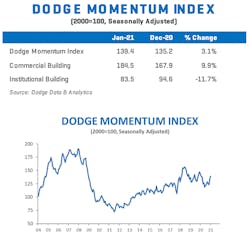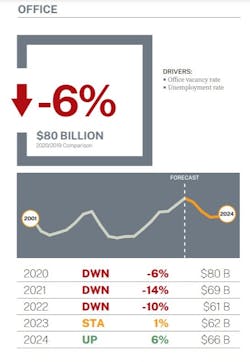Office Market Pins Hopes on Retrofits, Then 2022 Rebound
As I write this from my home office 30 miles outside Chicago, it strikes me that I have only been to my downtown office once in the last 11 months. In fact, it's not even there anymore, having moved to another suburban location that I have yet to visit.
Hardly a scientific measure, of course, but seeing how empty the daily commuter trains and station parking lots still are just in my little corner of America reinforces in my mind the precarious state of commercial real estate development and downtown office construction in 2021. As Richard Branch, chief economist for Dodge Data & Analytics, told Commercial Property Executive earlier this month, "Office construction will recover to some degree over the next several years, (but) the growing share of employees working from home will likely keep [it] below the levels seen in previous cycles.”
Even so, the Dodge Momentum Index (DMI) did record a 9.9% monthly increase in commercial building activity for January, suggesting a glimmer of hope for one of the markets hit hardest nationally in 2020. "However, the construction sector’s recovery will take time to materialize due to the deep scars caused to the industry by the pandemic," Branch cautioned separately. "Patience will be key in the months to come.”
That said, while new office construction will certainly lag in 2021, more and more building owners across the U.S. are investing in indoor air quality (IAQ) upgrades and improved ventilation as the best way to lure hesitant office workers back downtown.
"While the new construction market for buildings is expected to be weak this year, the retrofit market should be a good deal stronger," said Kermit Baker, PhD, Chief Economist, American Institute of Architects.
"Many existing commercial and institutional facilities need significant modifications to accommodate a post-pandemic staff and client base, and much of this activity is not included in the (monthly) construction spending figures," Baker added last month, upon release of the latest AIA Consensus Construction Forecast for 2021.
Incorporating the wisdom of AIA, Dodge Data, and seven other forecasting agencies, that consensus report predicted that the U.S. office construction market would slide another 9.3% this year, before leveling off and rebounding slightly in 2022 with a gain of 0.1%.
- To view the interactive AIA chart, click here.
Among the individual forecasters, Dodge Data was the most optimistic in the short term, predicting only a 0.6% downturn this year for new office projects, followed by a 4.4% rebound next year. For its part, Wells Fargo Securities' predictions are the most divergent, calling for a 15% drop in office construction in 2021, but a 6.3% turnaround next year. Grimmest is the vision of FMI Corp., which foresaw double-digit declines for both this year and 2022. In its own latest report released Feb. 1, FMI does not predict real recovery for the market until 2024. (See chart.)
In the shorter term, FMI stated, "Anticipate continued demand for data centers, life science research and development facilities through the forecast period. These subcomponents have bolstered overall office investment, avoiding more severe losses in 2020. However, oversupply of traditional office space in large metropolitans imparts strain on property valuations, landlords and financial institutions."
Despite that current "oversupply," experts still caution that any obituaries for the downtown office market are likely premature.
In his 2021 economic forecast for the Plumbing Heating Cooling Contractors Association, published Feb. 17, economist Bernard Markstein, PhD, predicted, "The traditional office is far from dead. Many companies will continue to incorporate some remote work but also maintain a central office... As with multifamily buildings, office buildings will require HVAC systems with high-quality ventilation that incorporates considerable outside air exchange and captures pollutants and pathogens. These systems need to be easy to care for with low-cost maintenance. Plumbing fixtures with touchless technology is another necessity. These items need to be included in both new office construction and in renovations. As relatively few new projects will be started over the next two years, most of the work will be for renovation of existing space."
With all that in mind, according the AIA Consenus Forecast, Markstein Advisors said last month that office construction was likely to fall another 4.6% this year, before stabilizing at 0.2% in 2022.
Even as new construction continues its pause, however, building owners are scrambling to remake their properties.
"Since the pandemic, our business has changed dramatically from trying to talk clients into servicing their systems properly into (us) being pushed (by them) very quickly into installing systems into new buildings," noted Scott Sherwood, president of Eco-Care Corp., New York City. Speaking at the ASHRAE Virtual Winter Conference in mid-February, he added, "Still, I would caution anyone to do their due diligence, to bring in engineers and facilities people, so that any upgrades they do, whether they involve MERV-13 or UV-C systems, will be handled properly."
Such work also accelerates considerable opportunity for greener office buildings.
As USGBC senior policy counsel Elizabeth Beardsley recently told Commercial Property Executive, the Biden Administration's new "Build Back Better" economic rescue plan should generate a lot of opportunity for real estate companies, particularly for those owners and operators who have been focusing on sustainability and improved resilience at their own facilities. In particular, firms working with the federal government now will benefit from its newly announced investments in thermal and energy storage, emissions-free vehicle charging, and other green technologies, she said.
In November, HPAC Engineering wrote about multipe design features* that could come to define the post-COVID office of the future, now manifest in Fulton East, a 12-story, 90,000-sq.-ft. office and retail building which just opened in December as Chicago's "first post-COVID-19 workplace."
From an HVAC point of view, the most significant adaptation to the original design is the addition of airPHX cold plasma air filtration units on each floor. Based in McLean, VA, the manufacturer says its technology creates and distributes a reactive oxygen species, which oxidizes pathogens and “continuously eliminating pathogens in the air and on all surfaces exposed to ambient air.”
Fulton East developers are banking on using this cold plasma technology throughout the entire building to help reduce cross-contamination risks — and provide potential tenants and their employees with cleaner air and work surfaces.
As 2021 progresses, of course, it will remain to be seen how effective these measures will be in Chicago and elswehere, not just in protecting building tenants, but in drawing them back into the office in the first place. Toward that end, the success of the now-escalating national vaccine rollout will undoubtedly be the key to this market's future.
##########
* Additional Fulton East COVID-19 protections include:
- All washrooms constructed with one fixture more than Chicago city code to help enhance social distancing;
- Sloan’s touch-free, solar-powered faucets, soap dispensers and flush valves — and SloanTec Hydrophobic Glaze on all vitreous washroom fixtures;
- Sherwin-Williams Paint Shield, an EPA-registered microbicidal paint that kills greater than 99.9 percent of staph, MRSA, E. coli, VRE and Enterobacter aerogenes within two hours of exposure on painted surfaces (applied on washroom walls);
- MAD Elevator Inc.’s Toe-To-Go hands-free elevator system, which uses foot-activated call buttons for a hands-free elevator experience, reducing the spread of germs;
- Touch-free thermal scanning at the lobby security desk to check people’s temperatures;
- Rosslare’s touch-free key fob access and security system, pre-wired for future Bluetooth low energy access via a mobile phone.;
- Butterfly, touch-free, after-hours security/building access/intercom/elevator access system;
- Private, in-building, exclusive parking providing direct, touch-free, secure access to tenant floors.
##########
Next month: Market focus on Healthcare construction.
About the Author
Rob McManamy
Editor in Chief
An industry reporter and editor since 1987, McManamy joined HPAC Engineering in September 2017, after three years with BuiltWorlds.com, a Chicago-based media startup focused on tech innovation in the built environment. He has been covering design and construction issues for more than 30 years, having started at Engineering News-Record (ENR) in New York, before becoming its Midwest Bureau Chief in 1990. In 1998, McManamy was named Editor-in-Chief of Design-Build magazine, where he served for four years. He subsequently worked as an editor and freelance writer for Building Design + Construction and Public Works magazines.
A native of Bronx, NY, he is a graduate of both the University of Virginia, and The John Marshall Law School in Chicago.
Contact him at [email protected].



